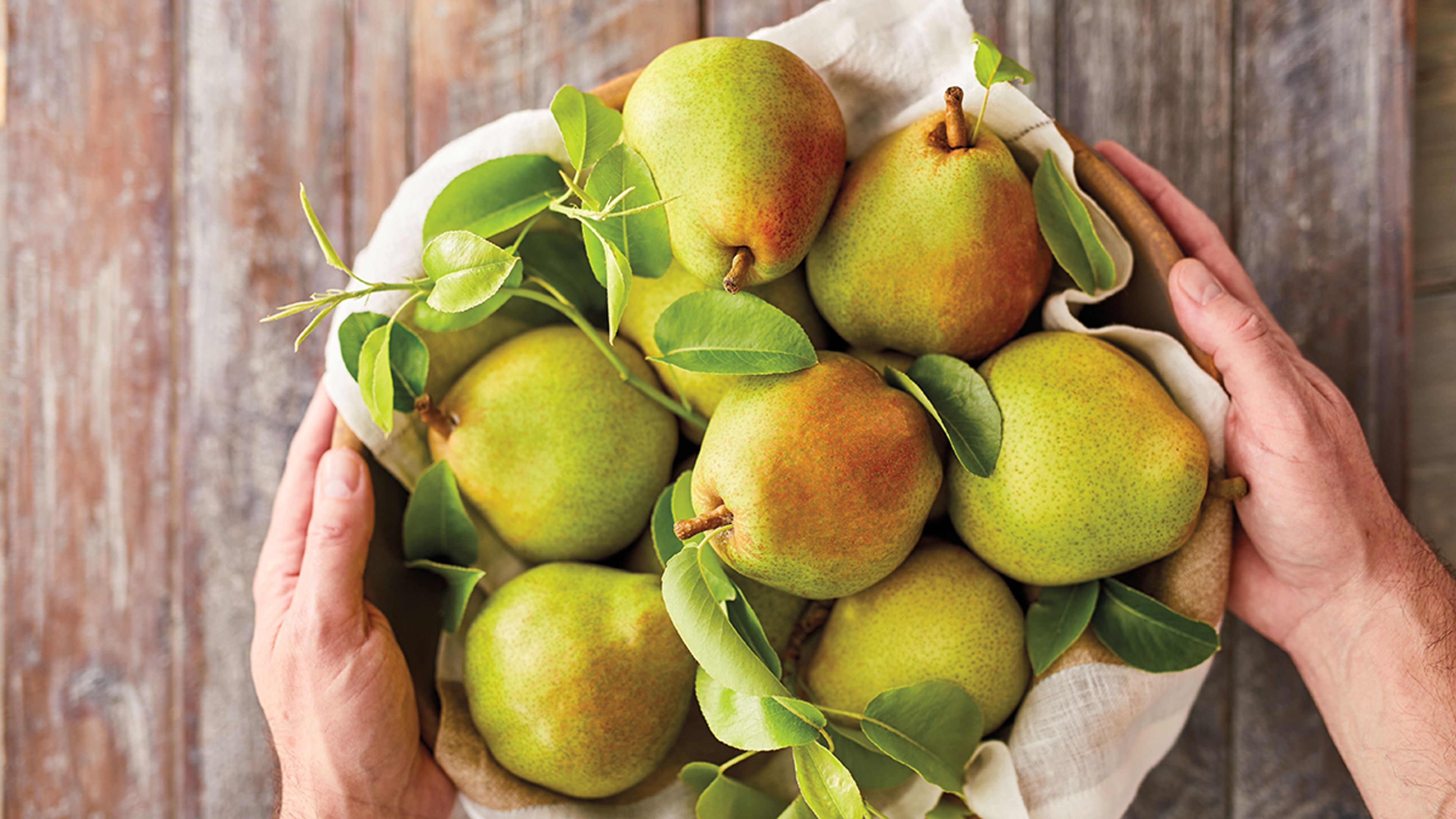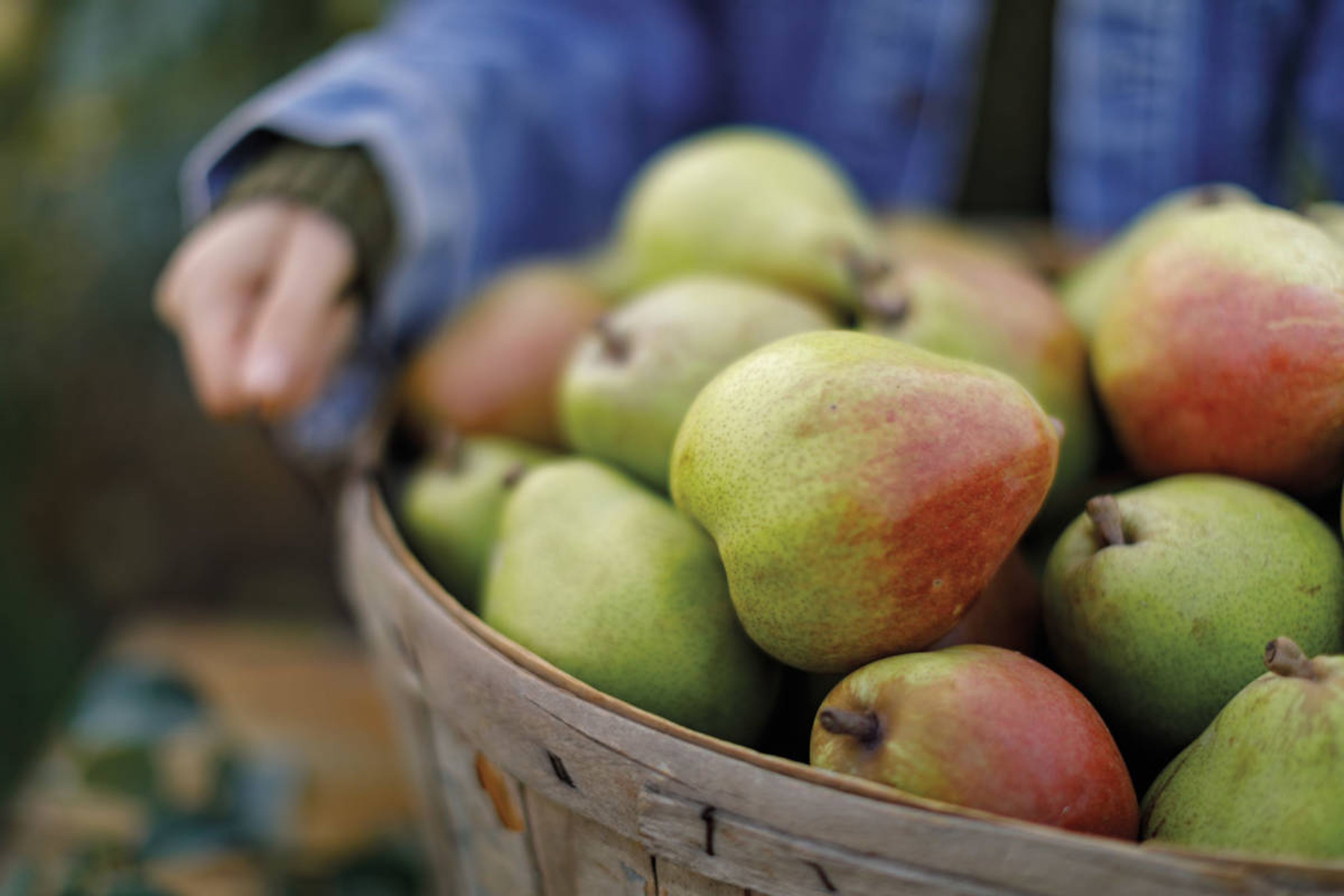The Perfect Pear: A Look at the Variety and Countless Uses For This One-of-a-Kind Fruit
A look at the 10 types of pears and how to cook them.
Jan 10, 2025
As anyone who has ever bitten into a sweet and juicy, perfectly ripened pear can tell you, this fruit is as flavorful and refreshing as any other. And, luckily, there are plenty of types of pears out there to satisfy even the heartiest of cravings.
More than 700,000 tons of pears are grown in the United States each year. That's enough for every man, woman, and child in the country to eat close to three pounds of the fresh fruit annually, and still have plenty left over for canning, baking, poaching, and other culinary uses as well.

While imported pears make it possible to enjoy this fruit year round, the locally grown kind are generally in season between August and October. This ensures that the low-calorie nutritional powerhouse (pears are packed with fiber, along with good levels of vitamin C and potassium) is readily available for snacking whenever the urge strikes. And with numerous types of pears out there to sample, and the countless ways they can be worked into meals, we're betting that's all the time!
History of pears
The history of the pear dates back more than 7,000 years. Around 5000 B.C., a Chinese diplomat named Feng Li became so obsessed with pears that he dedicated his life to growing and cultivating them. Thanks to his efforts, more and more people began eating fresh and cooked pears, and the beautiful, flowering trees from which they grow (which can reach up to 30 feet in height) quickly spread across Asia and into western Europe. Within a few hundred years, the fruit had become such a staple of Greek and Roman culture that the writer Homer even went so far as to describe pears as the ultimate “gift of the gods."
Where to find pears in the U.S.
Here in the U.S., early colonists from Europe brought pear trees with them when they settled the East Coast. The fruit then gradually spread across the country as later generations of settlers traveled west, explains Jim Morris, a spokesperson for USA Pears' northwest bureau.

Today, he says, the vast majority of pear trees are located in Oregon and Washington, where they grow and thrive in the nutrient-rich volcanic soil surrounding dormant volcanoes like Mount Hood and Mount Rainier. (Not so coincidentally, this region is also where Samuel Rosenberg's sons — company namesakes Harry and David — began operating the Bear Creek orchard in 1914 and, ultimately, started the company we know and love today.)
Types of pears
Although botanists estimate that there are thousands of different types of pears, around 10 key varieties make up the bulk of the pear crop grown and sold across the U.S. Here's how to identify each of them:
Shop : The Favorite® Royal Riviera® Pears from Harry & David
Comice pears: Beloved for their yellow-green coloring, which often includes a blush of red on one side, Comice pears are among the most popular — and desired — pears on the market.
“Comice pears stand out from other types of pears in terms of their texture, which is extremely buttery without the graininess found in some other varieties," says Jane Hunts, Merchandise Manager of Fruit for Harry & David. “They are also juicier than other varieties — so juicy, in fact, that it's been said you should eat them with a spoon."
According to Hunts, the Royal Riviera Pear, a variety of Comice, got its name because Harry and David's father, Samuel, used to “export the pears he grew to the high-end restaurants on the French Riviera, where European royalty spent their holidays." Ironically, the Comice pear's actual origin is in France. Known as the Doyenné du Comice, this varietal was first planted in 1849 in Angers, France, about three hours southwest of Paris.
“No other pear is as good for eating out of hand, using in salads, or pairing with cheese," Hunts says.
Shop : The Favorite® Royal Riviera® Pears from Harry & David
Bartlett pears: Also known as "Williams pears," Bartlett pears are the default pear most people think of when they think “pear." (You probably first encountered them as a child, bruised and battered at the bottom of your lunchbox after a day spent adventuring and knee scraping.)
With their classic pear flavor and butter-like texture, “these pears tend to be the easiest for farmers to grow and have the highest yield per acre," Hunts says. “They tend to be the most familiar to many consumers because they're so widely available."
Anjou pears: Firm and juicy with a hint of lemon flavor, Anjou pears rank just behind Bartletts in overall popularity in the U.S.
“They're a favorite choice for use in our premium pear gifts," Hunts adds. “We love the variety of their red and green colors. They're also one of the most versatile types of pears, good both for eating out of hand and for cooking."
Shop : Royal Riviera™ Pear Butter from Harry & David
French butter pears: As their name suggests, French butter pears are primarily used in the production of pear butter. They start out sour but sweeten significantly when ripe.
Shop : Royal Riviera™ Pear Butter from Harry & David
How to ripen at home
Unlike berries, bananas, and peaches, which are incredibly sensitive to spoiling, pears can typically be enjoyed at just the right level of ripeness. That's because, according to Morris, “the pear is one of the few fruits that does not ripen on the tree."
Instead, he says, almost all types of pears are harvested when mature but not yet ripe. This allows them to be transported more easily, and lets consumers ripen them at home until they reach the right desired color and texture.
“When left at room temperature, pears ripen from the inside out, slowly reaching sweet and succulent maturity," Morris adds. To speed the ripening process, try placing your pears in a paper bag or next to other ripening fruit, being sure to gently squeeze the neck of the pear daily until it yields to pressure — a sign the pear is ripe and ready to enjoy.
Our favorite pear recipes
While fresh, ripe pears may have the perfect combination of sweet, tart, and juicy flavor, they are also notable for their incredible ability to be used as an ingredient in a variety of prepared dishes. In most cases, all you need to do is wash and core the fruit, dice it into small pieces, and use it like you would any other ingredient.
“Pears are extremely versatile and lend themselves well to many different cooking methods," Morris says. “They pair — pun intended — particularly well with cheese."
From fresh garden salads to baked goods to savory meat dishes, pears can take center stage at mealtime in an almost infinite number of ways. Here are a few of our favorite pear recipes. They're absolutely pear-fect!
Start a meal with a bowl of creamy Pear and Butternut Squash Soup — it's a sweet and savory soup with a kick! For a quick and easy lunch, whip up a Cheesy Panini topped with slices of apple, pear, and sweet potato, or toss together a Pecan, Pear, and Bleu Cheese Salad. For a more hearty dish, sit the family down to Pear Pizza topped with a combo of fontina and tangy goat cheese; crispy Braised Chicken and Pears; or a Thanksgiving-esque mouthwatering Whole Roasted Chicken with Pears, Bacon, and Leeks.
To end your meal, you can't go wrong with any of these pear desserts: Spice Cake and Rosemary Pears, Caramel Pear Cheesecake Trifle, or the classic and decadent French Pear Tarte Tatin, which is perfect for cooks of all skill levels and is sure to become a new family favorite.
.svg?q=70&width=384&auto=webp)




























